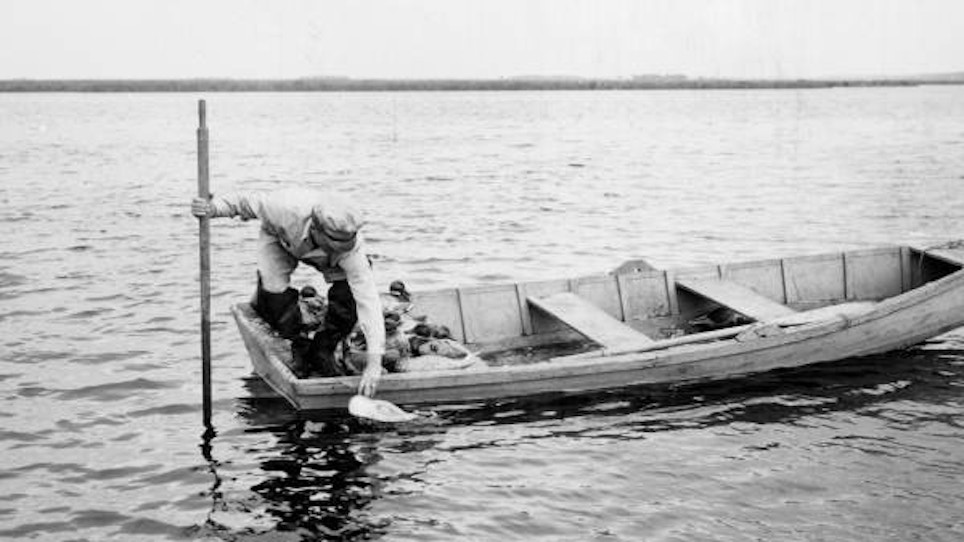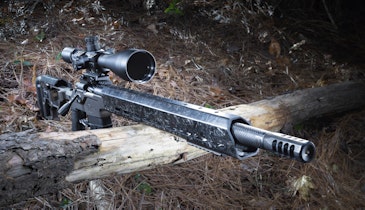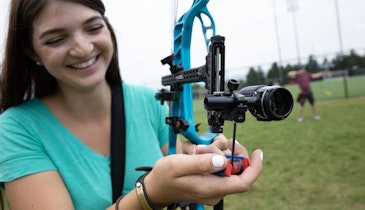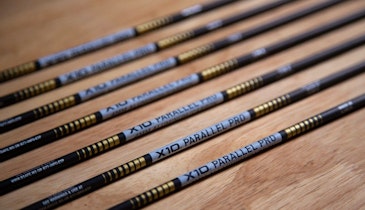Featured photo: State Archives of Florida
Many classic duck-hunting boats — the Barnegat Bay Sneakbox, the Scull Boat and the Nova Scotia Duck Tub, for example — were developed for use in the open marshes and bays of the East and North. But the South has its own originals as well, including these classic southern duck boats.
Pirogue
Native American dugouts were the original pirogues. Southerners initially made these sleek little boats as the Indians did — by  shaping cypress logs with fire, axes and adzes. However due to the increasing market value of cypress logs coupled with the increased availability of sawn planks, plank pirogues began replacing dugouts after the turn of the 20th century. Today’s pirogues usually are constructed from cypress planks, marine plywood, fiberglass or aluminum. Yet most are light enough for a single individual to carry without help. The best will float on a heavy dew and can be paddled or push-poled with ease.
shaping cypress logs with fire, axes and adzes. However due to the increasing market value of cypress logs coupled with the increased availability of sawn planks, plank pirogues began replacing dugouts after the turn of the 20th century. Today’s pirogues usually are constructed from cypress planks, marine plywood, fiberglass or aluminum. Yet most are light enough for a single individual to carry without help. The best will float on a heavy dew and can be paddled or push-poled with ease.
Many pirogues are rather tippy. Robert Ruark once wrote, “A pirogue is a water-going ashtray that will capsize if you shave more closely on one side of the face than on the other.” Nevertheless, a good boatman in a pirogue can negotiate shallow stump-filled waters, portage easily when needed, paddle swiftly over considerable distances and tend to much of the work of a swamper: running fishing lines, following wetland game trails, gliding up silently on fat frogs and, of course, sneaking up on ducks.
Atchafalaya Basin Bateau
During the first half of the 20th century, this big flat-bottom boat (often 24 feet long and 3 feet wide at the bottom) was as common to Mississippi Valley swamp dwellers as the Model T was to drylanders. Made as an all-purpose vessel, it was popular with waterfowlers of the marshes. The bateau was used for a wide range of fishing activities as well, and also provided basic travel and transport for many swamp families in the Atchafalaya.
 Some called the bateau “mud boat” because it easily traversed wet, shallow trails. A more common moniker was “bateau putt-putt,” a name derived from the peculiar sound of the motor used to power the bateau. This was an inboard, gasoline motor, two-cycle and water-cooled. It came in single cylinder (2 1/2 hp and 4 hp) and double cylinder (6 hp and 8 hp) models. The Lockwood-Ash company of Michigan first produced these motors prior to World War I, permitting Sears and Roebuck to sell them under the name “Motorgo” as early as 1916. The motors remained in demand in the Atchafalaya Basin long after they were obsolete elsewhere in the country. Nadler Foundry and Machine Company of Plaquemine continued to recondition and machine parts for them into the late 1940s.
Some called the bateau “mud boat” because it easily traversed wet, shallow trails. A more common moniker was “bateau putt-putt,” a name derived from the peculiar sound of the motor used to power the bateau. This was an inboard, gasoline motor, two-cycle and water-cooled. It came in single cylinder (2 1/2 hp and 4 hp) and double cylinder (6 hp and 8 hp) models. The Lockwood-Ash company of Michigan first produced these motors prior to World War I, permitting Sears and Roebuck to sell them under the name “Motorgo” as early as 1916. The motors remained in demand in the Atchafalaya Basin long after they were obsolete elsewhere in the country. Nadler Foundry and Machine Company of Plaquemine continued to recondition and machine parts for them into the late 1940s.
During the 1950s, the bateau was rapidly replaced by shorter flat boats powered by outboard motors. By the late 1960s, few remained. However, a renewed interest in the bateau, beginning in the mid 1980s, has resulted in many restoration and new construction projects.
The Reelfoot Stumpjumper
The most unique boat used by Southern waterfowlers must be the Reelfoot stumpjumper.
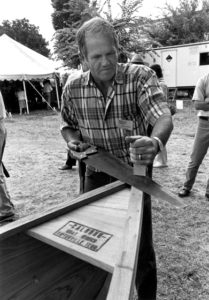
Dale Calhoun is acclaimed as one of the last builders of the Reelfoot Lake stumpjumper. Photo: Robert Cogswell, Courtesy Tennessee Arts Commission
First built more than 150 years ago, about the time of the Civil War, these slim, shallow-draft boats are ideal for navigating shallow, timber-filled waters such as those on Tennessee’s Reelfoot Lake where the boat originated. The most unique feature is a set of ratcheted, bow-facing oars that allow the
user to see where he’s going while rowing. Small inboards and guarded rudder systems added in the 1930s allow the boats to glide over submerged stumps, hence the name.
Many people have made stumpjumpers over the years, and no one knows for sure who created the first one. But the boat’s heritage definitely belongs to the Calhoun family of Calhoun Boat Works in Tiptonville, Tennessee. Four generations of Calhouns have made and sold stumpjumpers.
It was Boone Calhoun, in 1884, who first installed the bow-facing oars, which were designed by Fred Allen on Monmouth, IL. Later, when Maytag washing machines came out with small gasoline-powered engines, Boone’s son Bill took one of the engines, installed it in a boat and connected it to a single-shaft, shallow-running propeller that propelled the craft. Bill’s son Dale later added a propeller guard to shield the prop from weeds.
Despite these innovations and others, what you see now in a Reelfoot stumpjumper is what you would have seen in the 1800s. The boat is an enduring classic still used by duck hunters on Reelfoot Lake and elsewhere.
